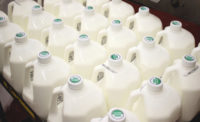Analysis: global milk pricing to ease this spring

An analysis of the global dairy industry by Rabobank, New York, forecasts an easing of global milk pricing through June. Rabobank’s Food & Agribusiness Research and Advisory group said that the exportable dairy supply rose strongly in the last three months of 2013, and is expected to continue into 2014 as producers respond to improved margins through high milk prices and falling feed costs.
The bank expects a strong Northern Hemisphere production season following what it termed “an exceptional” season in the Southern Hemisphere to generate more than enough exportable supply to exceed China’s needs from the world market. However, a Rabobank analyst said that the rate of price reduction will be limited by structural constraints on suppliers, the need to replenish depleted buyer inventories and ongoing demand growth in line with a slow economic recovery.
“The most crucial demand-side question is whether China will sustain the frenetic buying we have seen on the international market throughout the last 12 months,” said Rabobank analyst Tim Hunt.
Growth: strong in EU, modest in USA
Looking at various world regions, Rabobank expects production to rise by 4% year-over-year in the European Union for the first half of 2014, fuelling a surge in exports. The U.S. domestic market is expected to show modest growth, as slow economic growth and reductions in SNAP payments (federal government food stamps) are compounded by further increases in retail pricing.
As for Oceania, the bank said the final three months of the New Zealand season (to May 2014) will see production that is at least 20% to 30% higher than the drought-impacted finish of the 2013 season. And in Australia, producers saw a recent rise in milk flow, albeit marginal. Rabobank expects a further recovery in milk flows in the first half of 2014, on the back of better weather and higher milk prices.
And in South America, a drought in Brazil’s southeast, coupled with weak local demand growth, is expected to slow Brazilian supply growth, simultaneously reducing import activity as supply expands faster than local demand. Rabobank expects only modest year-over-year production growth in Argentina.
Looking for a reprint of this article?
From high-res PDFs to custom plaques, order your copy today!








